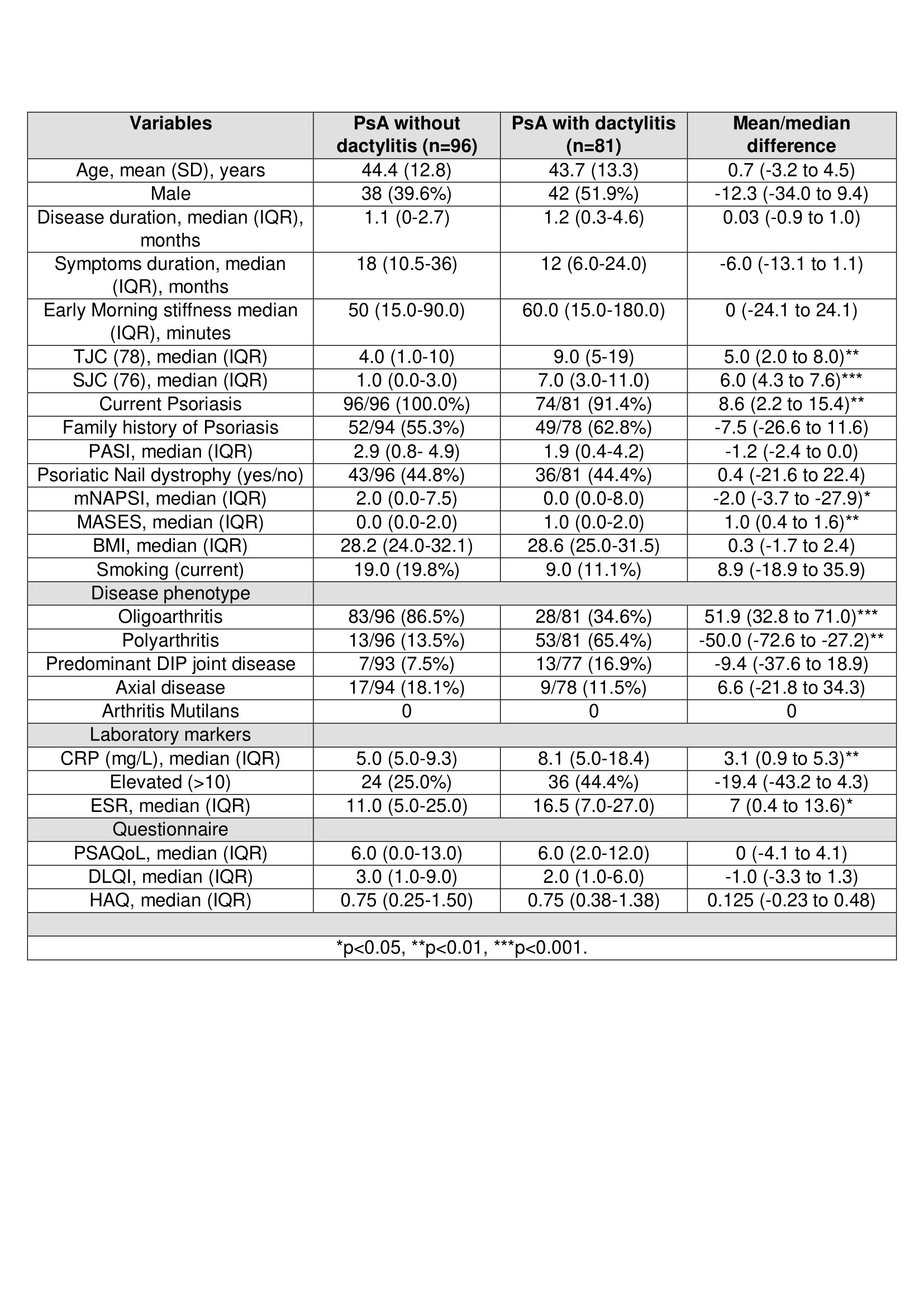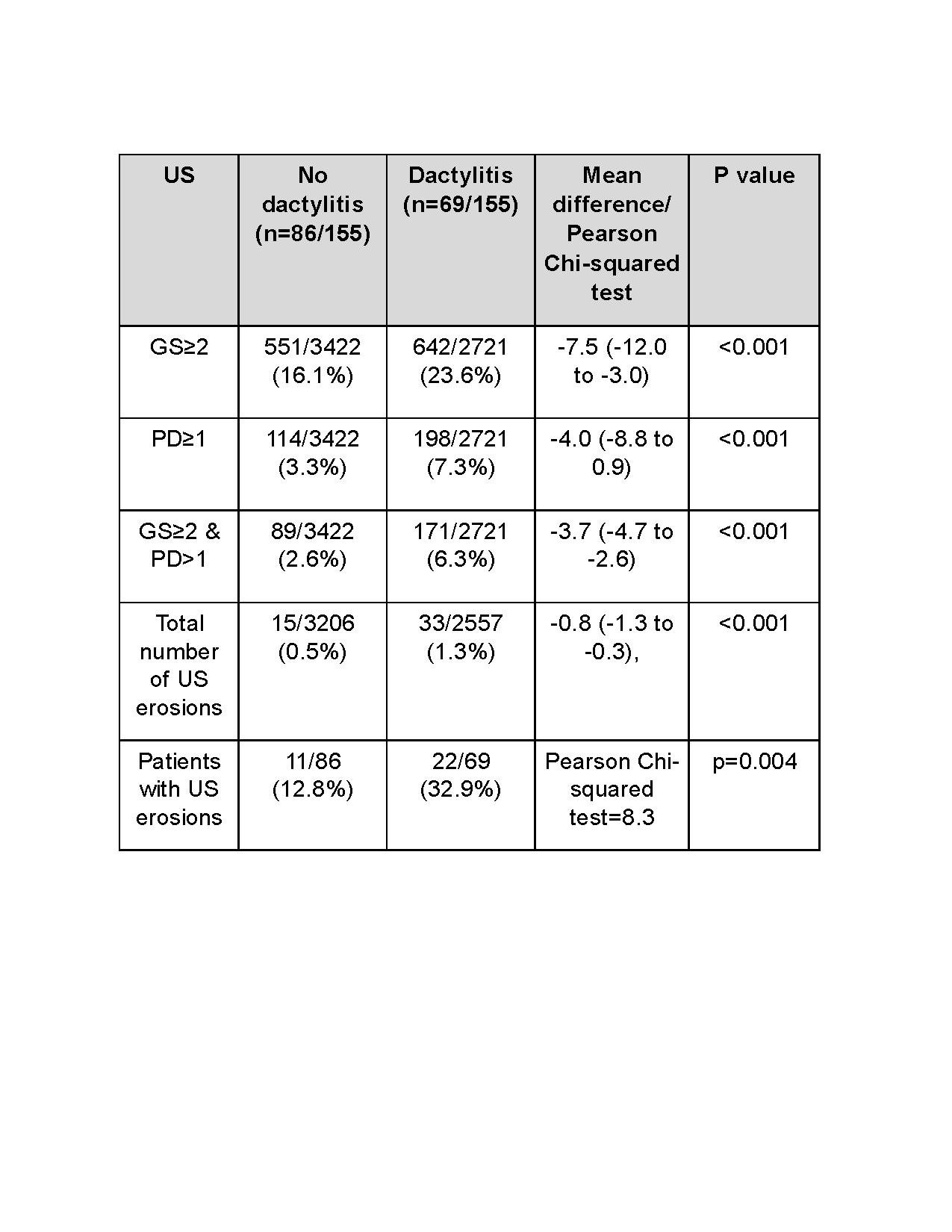Session Information
Date: Friday, November 6, 2020
Session Type: Poster Session A
Session Time: 9:00AM-11:00AM
Background/Purpose: Dactylitis is a hallmark feature of Psoriatic arthritis (PsA), defined as a uniform swelling of a finger or toe (“sausage digit”). It is associated with radiographic damage in chronic PsA. However, there are paucity of data on its characterisation, phenotypical significance, and disease burden in very early PsA. The objective of this study was to characterise a very early DMARD naïve PsA cohort based on the clinical presence or absence of dactylitis.
Methods: Very early PsA patients fulfilling CASPAR criteria were recruited into a prospective observational study; the Leeds Spondyloarthritis Register for Research and Observation (SpARRO). The cohort was evaluated based on presence/absence of dactylitis. Dactylitis was recorded per digit as tender (“hot”) or non-tender (“cold”). Statistical differences between mean, medians, and proportions were calculated using student’s t-test, quantile regression, one-sample tests, and Pearson Chi-squared test. Ultrasonography (US) of joints was conducted by trained sonographers blinded to clinical details. Synovitis was graded for grayscale (GS) and power Doppler (PD) using the semiquantitative method (0-3) at 48 joints: wrists, MCP1-5, PIP1-5, DIP2-5, MTP1-5, knees, ankles, subtalar and talonavicular joints. Bone erosions were determined by US if cortical bone discontinuity was present in two perpendicular planes (longitudinal/transverse).
Results: A total of 177 patients were recruited. Dactylitis patients recorded significantly higher median difference in TJC (p< 0.01), SJC (p< 0.001), and CRP (p< 0.01) compared to PsA without dactylitis. Table 1 outlines the characteristics of the cohort. Dactylitis was present in 81/177 (46%) patients and 214 digits. Multiple digits ( >1) were involved in 51/81 (63%) patients, asymmetrical in 52/81 (64%). Dactylitis was more prevalent in toes (146/214; 68.2%) than fingers (68/214; 31.8%). “Hot” dactylitis was more prevalent (179/214; 83.6%) than “cold” dactylitis (35/214; 16.4%). The most frequent sites for “hot” dactylitis were 2nd finger (23/179; 12.8%), 4th toe (40/179; 22.3%) and for “cold” dactylitis, 3rd finger (2/35; 8.5%), 4th toe (10/35; 28.5%). Significantly greater US synovitis was identified in PsA with dactylitis (p< 0.001) determined by either GS≥2, PD≥1, or GS≥2+PD≥1 as shown in table 2. Ultrasound defined erosions were also significantly greater in joints of patients with dactylitis (p< 0.001) overall and were identified in significantly more patients with dactylitis compared to patients without dactylitis [22/69 (31.9%) versus 11/86 (12.8%) patients; p=0.004] (table 2). Sites most prone to erosive damage were MCP2 (9/33, 27.3%), MTP5 (11/33, 33.3%).
Conclusion: This study identifies dactylitis as a clinical indicator for an aggressive phenotype with significantly greater TJC, SJC, CRP, US synovitis and US defined erosions in very early DMARD naïve PsA, compared with PsA without dactylitis. Longitudinal follow-up will determine if dactylitis represents poor prognosis at this very early disease stage. Dactylitis may be a useful discriminator for risk stratification in future PsA management strategies and clinical trials.
 Table 1: Baseline characteristics of the PsA cohort by the presence or absence of dactylitis.
Table 1: Baseline characteristics of the PsA cohort by the presence or absence of dactylitis.
 Table 2: Significantly greater synovitis and erosions in ultrasound scanned joints in PsA with dactylitis compared to PsA without dactylitis.
Table 2: Significantly greater synovitis and erosions in ultrasound scanned joints in PsA with dactylitis compared to PsA without dactylitis.
To cite this abstract in AMA style:
Dubash S, Alabas O, Michelena X, De Marco G, Garcia-Montoya L, Wakefield R, Tan A, Helliwell P, Emery P, McGonagle D, Marzo-Ortega H. Dactylitis Is Associated with Greater Disease Severity, Ultrasound Synovitis, and Erosive Damage, in Very Early DMARD Naïve Psoriatic Arthritis [abstract]. Arthritis Rheumatol. 2020; 72 (suppl 10). https://acrabstracts.org/abstract/dactylitis-is-associated-with-greater-disease-severity-ultrasound-synovitis-and-erosive-damage-in-very-early-dmard-naive-psoriatic-arthritis/. Accessed .« Back to ACR Convergence 2020
ACR Meeting Abstracts - https://acrabstracts.org/abstract/dactylitis-is-associated-with-greater-disease-severity-ultrasound-synovitis-and-erosive-damage-in-very-early-dmard-naive-psoriatic-arthritis/
